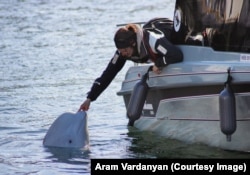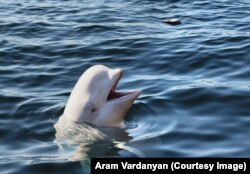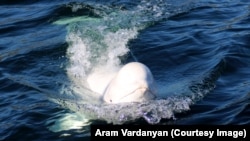A friendly beluga whale that made headlines around the world after claims it was part of a Russian “special ops” force is now dependent on 20 kilos of handout herring every day at its new Norwegian home to stay alive.
In April, the whale -- who has been dubbed "Hvaldimir" -- appeared in Norwegian waters sporting a harness and eager to interact with people, leading to speculation the beluga had escaped from a Russian military facility.
The harness -- which was removed -- had "Equipment St. Petersburg" written on it and reportedly had a mount for a camera.
But two months later, the whale’s origin remains unknown, despite global media attention.
And fame has not brought happiness to Hvaldimir -- a portmanteau of “hval,” the Norwegian word for whale, and the Russian name Vladimir.
Richard Karoliussen, a co-founder of the Norwegian Orca Survey, told RFE/RL the beluga appears to have been entirely dependent on people in its mysterious previous life.
“We saw he can’t feed himself and [Norwegian] animal welfare law cannot allow animals to suffer. So the authorities gave us permission to feed him…. We don’t want him to die.”
Karoliussen says tourists were feeding Hvaldimir “bread, fishcakes, anything you can imagine,” which is not healthy for him. Now Karoliussen's team holds feeding sessions that allow the whale to interact with people “on our terms.”
Some encounters have revealed Hvaldimir’s remarkable, sometimes unnerving, abilities.
In June, commercial diving supervisor Tom Ralph said he was working underwater when the beluga pulled a knife from another diver’s scabbard, then “backed away about a meter and just sat there with this knife in its mouth.” The dive was reportedly called off as a precaution. Another interaction, this one captured on video, shows the whale retrieving a smartphone after it slipped from a woman’s pocket into the sea.
On June 16, travel writer Aram Vardanyan (who shot the photos in this story) watched the whale being fed from a pier in Hammerfest harbor. Vardanyan says Hvaldimir drew a crowd of around 20 mostly foreign tourists.
“I saw the people gathering, then the lady on the boat shouted ‘ok, today we’re going to be taking care of the animal.' She was using different hand gestures, it looked like she was trying to learn its language.”
Captive belugas are known for being highly interactive with humans and Karoliussen says the hand gestures stimulate the animal and also prepare it for potential medical attention. “We are training him to lay beside the boat in case he gets sick and we need to access his body.”
Although the plan is to eventually wean Hvaldimir off the handout fish so he can fend for himself, Karoliussen sounds unsure of what lies ahead for this domesticated animal, living alone in the wild.
“Our mission right now is to maintain the animal and keep him alive," he said. "Beyond that I don’t know. The plan for the future is not in our hands.”












